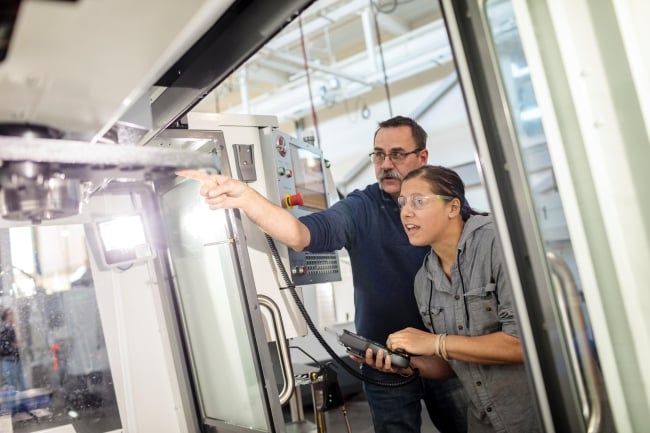You have /5 articles left.
Sign up for a free account or log in.

At Clackamas Community College, students can earn certificates for in-demand entry-level roles to kick-start their socioeconomic mobility while earning baseline credentials that can later stack into a degree.
Clackamas Community College
For many college students, educational experiences pay off years down the road when they enter their career after earning a degree. But that long runway could be growing shorter—for a growing number of community college students, a better-paying job could be as close as three months away.
Clackamas Community College in Oregon has established a slate of short-term workforce programs to meet regional workforce needs, helping students achieve higher wages and build toward an associate or bachelor’s degree in just a few terms.
The new programs join a national trend of building a series of stackable credentials from already-offered degrees that are responsive to local job markets while still propelling student learning in higher education.
The background: One of the institution’s goals is to design programs that meet industry demands and then support workforce leaders and students to ensure student success, explains Armetta Burney, dean of technology, applied sciences and public services at Clackamas.
In the state of Oregon, community colleges in 2004 first started to offer career pathway programs, which are intended to be one or two terms to get the learner launched into a new career, says David Plotkin, vice president of instruction and student services at the college.
“An interest in short-term pathways has actually become, I think, more visible in higher ed over the last few years,” Plotkin says. “And so we have been encouraging our faculty to look at, where can we do that?”
Each of the college’s technical education programs also has an advisory council made up of practitioners or industry leaders from the field who help guide and develop curricula. “Our faculty are great about being connected to folks in industry, and as administrators, we try to listen to what they’re hearing and encourage them to be in dialogue,” Plotkin says.
Survey Says
Recent Student Voice survey data by Inside Higher Ed and Generation Lab found 19 percent of two-year college students believe accelerated eight-week courses would benefit their academic success.
How it works: Clackamas offers more than 20 career pathways, which are the first “layer of potential” in the career and technical programs, Burney explains.
The largest industries in the region are manufacturing, health care and technology, and many of the career pathways service these fields.
Each pathway ranges from 12 to 44 credits, and each is designed to get students ready for an entry-level position. Once they finish the certificate, they can move into that position, no further education required. However, for students who would like to continue, they can stack credits into a certificate of completion (one-year program) or an associate of applied science degree (two-year program).
“What’s so unique and advantageous … is that it gives students the opportunity to gain some skills, transition to industry, to use those skills,” says Burney. “And then when they’re ready, they can come back and build upon those existing skills without wasting any credits, time or money.”
The program offering is beneficial for a variety of student types as well, whether they’re traditional-aged high school graduates or workers looking to launch into a new career or needing to upskill.
The CNC operator certificate, for example, is a specialized focus from the machine tool technology degree that helps address changing job demands in the industry, giving workers the opportunity to reskill or specialize in some way.
“Any short-term certificate that we’re offering, we want to make sure that we’re combining courses in a way that helps to move our students into industry as those entry-level contributors, and then making sure that the that specific credential is aligned to the larger degree,” Burney says. “We always want to be mindful of ensuring that we’re maximizing our students’ time and their resources.”
Many of the programs also incorporate industry-recognized credentials, which further help increase the competitiveness of students.
Building for tomorrow: In addition to supporting the workforce and helping students reach their goals, the program also helps prepare students for continued education.
“Community college students are the most vulnerable students in higher education,” Plotkin says. “They often don’t believe they belong in college, and so allowing them to get this credential allows them to build the confidence that says, ‘Yeah, I do belong in college’ … and then that leads them to believe, ‘Oh, if I can do this, what more can I do?’”
The program provides essential life skills training and provides the foundations to transfer to a four-year degree. “We’re wanting to encourage students to be lifelong learners, because for their careers, they will have to be. Even if they stay in the same field, the field will not be recognizable in 20 years, and they need to learn how to keep up with that,” Plotkin says.
College administrators will continue to evaluate the effectiveness of the programs, adapting and innovating as technology changes to ensure students are receiving the best education possible.
If your student success program has a unique feature or twist, we’d like to know about it. Click here to submit.








